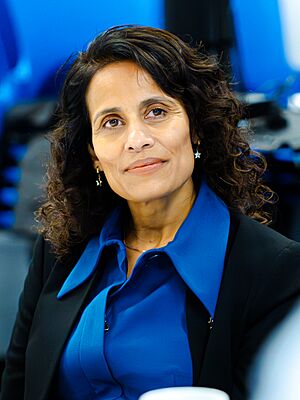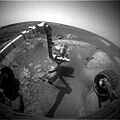Vandi Verma facts for kids
Quick facts for kids
Dr.
Vandi Verma
|
|
|---|---|

Verma in 2024
|
|
| Born |
Vandana Verma
|
| Other names | Vandi Verma Tompkins |
| Education | Kendriya Vidyalaya No. 2, Halwara |
| Alma mater | Punjab Engineering College Carnegie Mellon University |
| Known for | Mars Exploration Rovers Mars Science Laboratory PLEXIL |
| Scientific career | |
| Fields | Robotics, artificial intelligence, autonomous robotic systems |
| Institutions | NASA's Jet Propulsion Laboratory |
| Thesis | [thesis Tractable Particle Filters for Robot Fault Diagnosis] (2005) |
Vandana "Vandi" Verma is a super smart engineer at NASA! She works at the Jet Propulsion Laboratory (JPL) and is famous for driving the Mars rovers. She even helped create the special computer programs, like PLEXIL, that make these robots move on Mars. She has driven rovers like Curiosity and Perseverance!
Contents
Vandi Verma's Early Life and Education
Vandi Verma grew up partly in Halwara, India. Her dad was a pilot in the Indian Air Force. She first studied electrical engineering at Punjab Engineering College in India.
Becoming a Robotics Expert
Later, she moved to the United States. She earned a master's degree in robotics from Carnegie Mellon University (CMU). Then, in 2005, she got her PhD in robotics from the same university.
Exploring Unknown Places
At CMU, Vandi became very interested in robots that could work in new or difficult places. She spent three years working on a science project in the Atacama Desert. This desert was chosen because its harsh environment is similar to the surface of Mars. She also tested robot technologies in the Arctic and Antarctic.
From Pilot to Engineer
Between her studies, Vandi even got her pilot's license! Her first job after university was as a research scientist at Ames Research Center.
Vandi Verma's Work at NASA
In 2006, Vandi helped create PLEXIL. This is an open source computer language. It is used in many automated systems. These include NASA's K10 rover and the drill on the Mars Curiosity rover. It also helps with the International Space Station.
Joining the Mars Rover Team
In 2007, Vandi joined NASA's Jet Propulsion Laboratory (JPL). She focused on robotics and flight software. The next year, she became part of the Mars rover team. By 2019, she was leading JPL's group for autonomous systems and robotics.
Sharing Science with Kids
Vandi often takes part in JPL's open house events. She also connects online to talk about science. She loves to encourage children, especially girls, to explore careers in STEM.
Driving Robots on Mars
Vandi Verma has worked on NASA's Mars Exploration Rover projects since 2008. She has operated all three of the original rovers. These are MER-A Spirit, MER-B Opportunity, and Curiosity.
Living on Mars Time
To drive the robotic spacecraft efficiently, the team adjusts to the Martian day. A Mars day, called a sol, is about 40 minutes longer than an Earth day. This means the team starts their workday 40 minutes later each day. Vandi says, "We tend to live by the Mars clock and many have Mars watches."
How Rovers are Driven
Driving a rover is a very slow process. Commands can take from four to 20 minutes to reach Mars. So, commands are usually tested first in a simulation. Many commands are sent at once using NASA's Deep Space Network. Signals are relayed through the Mars Odyssey orbiter.
Teamwork for Exploration
Operating a rover is a huge team effort. Scientists from different fields work together. A typical set of commands involves:
- Looking at past 3D images.
- Making a plan and route to explore as much as possible.
- Making sure the rover stays safe.
- Using Curiosity's 2-meter robotic arm.
- Practicing and simulating the rover's movements.
- Putting all the steps into detailed instructions.
In 2012, Vandi said, "I do realise that I possibly have one of the coolest jobs in the world."
Awards and Recognition
Vandi Verma has received many awards for her team's work, including:
- 2008: NASA Earth Science team award for Intelligent Autonomy Technology Transition Team
- 2010: NASA Honors award to the MER Electro-mechanical Failure Mitigation Team
- 2013: NASA Honors Award to the MSL Motor Control Team
- 2013: NASA Honors Award to the MSL Surface Sampling and Science Systems Team
- 2013: NASA Honors Award to the MSL Testbed and Simulation Support Equipment Team
- 2014: NASA Software of the Year Award, given to the Mars Science Laboratory Flight Software Team
- 2016: MSL AEGIS Team Award
- 2017: MSL CHIMRA (Collection and Handling for In-Situ Martian Rock Analysis) Award for Tunnel Anomaly Recovery
Vandi Verma in Media
Vandi Verma has appeared in several films and documentaries.
- In 2011, she was in and directed an episode of Nova ScienceNow called Can We Make It to Mars?.
- She appeared in the US Air Force documentary Science in the Extremes series 3, episode 6 by Seeker. In this, she explained her work on Mars' surface.
- In 2018, Finnish director Minna Långström made a documentary about Vandi. It was called The Other Side of Mars. The film looked at how images from Mars are made and used.
- In 2022, Vandi appeared in Good Night Oppy. This documentary told the story of the Spirit and Opportunity rovers.
Images for kids
-
MER team members Alfonso Herrera, Vandana Verma, Bruce Banerdt, testing Spirit rover
See also
 In Spanish: Vandi Verma para niños
In Spanish: Vandi Verma para niños
- Adam Steltzner
- Anita Sengupta
- Bobak Ferdowsi
- List of missions to Mars




